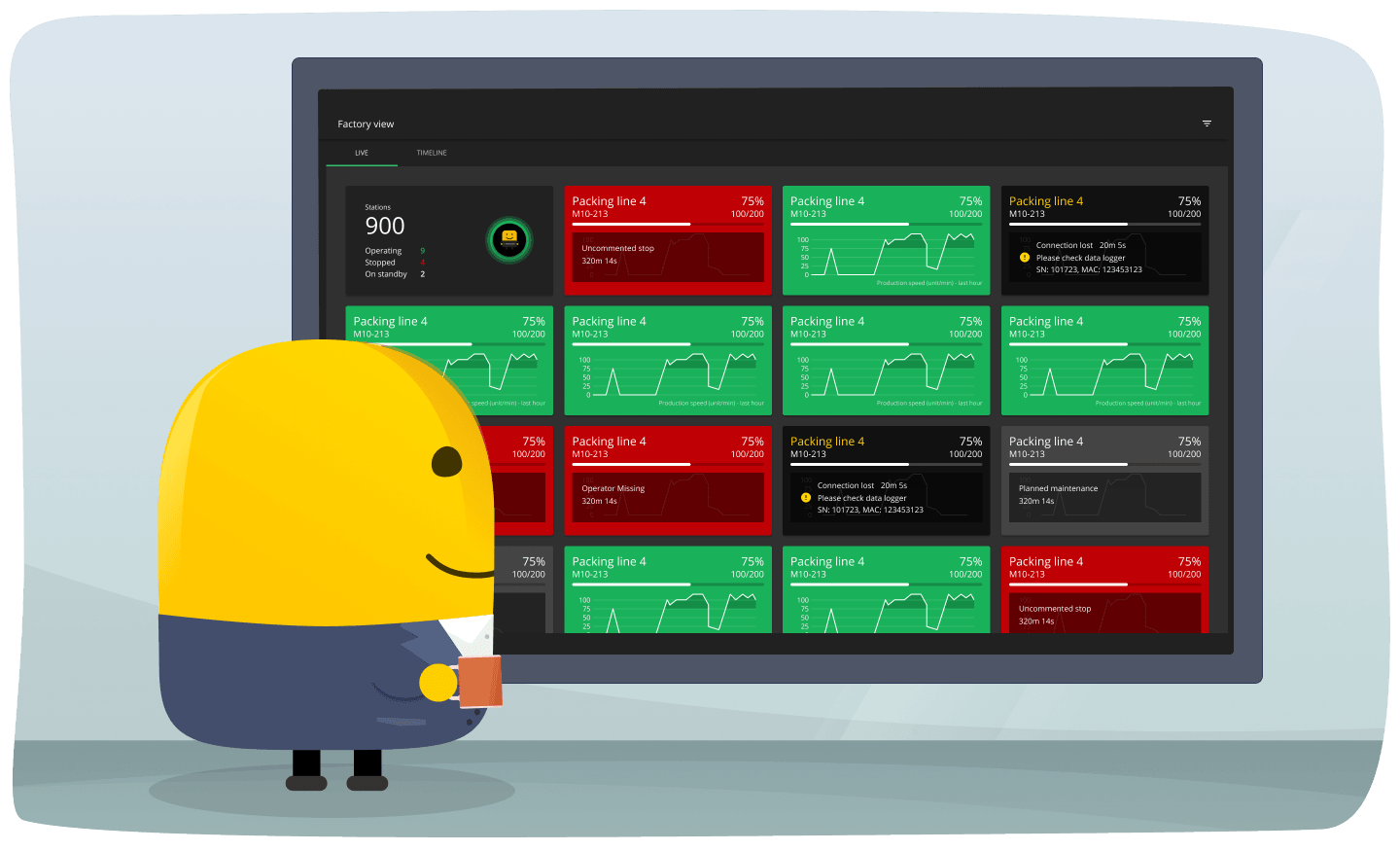As the Lean Manager of a manufacturing plant, your primary focus is on the elimination of waste. In this article, we discuss the benefits to Lean Managers of Evocon’s OEE software and IIoT solution.
Evocon Helps Lean Managers Identify Waste Faster
Ever since Lean became the buzzword of the 1990’s business world, a central challenge of the Lean Manager has been the identification and prioritization of improvement activities to eliminate the Six Big Losses.
Once the opportunity has been identified, the lean tool kit of value stream mapping, voice-of-the-customer, etc. makes the business of actually improving the process fairly straightforward (in the hands of the skilled practitioner that is). But before you can apply these tried and true tools, the opportunity to eliminate waste requires identification. As we will see, this is where Evocon and OEE can be of benefit to the Lean Manager.
Learn more: What is OEE and How Does It Work?
Why Lean Managers Matter
Maybe you are actively supporting problem-solving on the manufacturing floor. Or you are serving as an evangelist of lean principles to machine operators and managers alike. Either way, you represent one of the most effective manufacturing management philosophies in history.
As a practitioner of Lean, you know that your job of waste identification and elimination is a journey without end. You have machines, operators, processes, and methods to evaluate and analyze. You also must ensure the development of lean workflows and their implementation. While you handle that, you’ll also be providing training and coaching on lean principles and concepts. You work tirelessly to instill a culture of waste identification and elimination. This means engaging every member of the workforce in these efforts.
It’s a big job and one that often will require focus on several manufacturing plants. This is why it is critical to leverage new technologies and tools at every opportunity.
3 Critical Challenges of Lean Managers
- What are the largest sources of waste in our process?
- What is the source of the biggest production losses?
- Can everyone on the shop floor see and understand how the operation is performing at all times?
- Is everyone on the shop floor involved in problem solving and process improvement?
These are just a few of the questions that are likely on your mind on a day-to-day basis. The answer to the first two come from production data. The answer to the last two questions you find by a quick walkthrough of the plant. However, challenges exist for organizations which do not have technologies in place to monitor and capture data on the production process.
1. Identifying and quantifying sources of waste
As a Lean Manager, one of your most important and challenging roles will be identifying and quantifying sources of waste in your plant. Not only will your involvement in this process be routine, but also, at its best, you will effectively enlist the entire workforce in the effort as well. The question will be how much time will it require in order to identify the sources of waste? Of you? The plant management team? And of course, operators on the shop floor?
When a company first begins its lean journey, the sources of waste may very well be highly visible, such as WIP inventory building up in front of bottleneck resources. But over time, the search for sources of waste becomes more challenging. As this happens, the need and reliance on data on the production process grow.
Until recently, this meant using either pen and paper or excel to collect data. These methods, while plagued with problems such as timeliness and accuracy, were the best that manufacturers and Lean Managers had at their disposal. As we will see, Evocon is at the forefront of changing this situation. This is being accomplished by providing access to low cost, easily implementable, and highly effective OEE tracking and production monitoring tools.
2. Creating a visual factory
James P. Womack, Lean Thinking: Banish Waste And Create Wealth In Your Corporation
“The precise techniques will vary with the application, but the key principle does not: Everyone involved must be able to see and must understand every aspect of the operation and its status at all times.”
At the heart of Womack’s quote is the need for a visual factory. Or, put another way, the need for manufacturers to be able to visualize production in real-time. To understand this challenge, let’s discuss a common scenario.
The shift meeting begins with a discussion of yesterday’s performance. The results are in, and it isn’t a pretty picture. Questions arise from supervisors and managers alike. Just what happened on the filling line yesterday? There isn’t a good answer. Further, the consensus is complicated by the fact that when everyone went home yesterday, the feeling was that it had been a good day on the line.
After some discussion, the consensus becomes that the speed setting on the machine was wrong. An operator checks the machine. And indeed, for some reason, it was set incorrectly for the item that was run the previous shift.
While the solution for the symptom has been addressed, there might be a better question. Such as, why didn’t anyone on the floor notice that the line wasn’t running well yesterday?
The answer is that they didn’t have any means of visualizing production performance in real-time. This is why Lean Managers are so obsessed with creating systems that allow for everyone involved to quickly and visually see how the line is performing at any given time. With visual management tools in place, you can see problems and resolve them while there is still time to alter results.
Learn more: Production Data Visualisation Drives Engagement & Productivity

3. Empowering and engaging operators
Engaged and empowered machine operators are a powerful tool in the Lean Manager’s fight against waste in all its forms. Simultaneously, the task of empowering and engaging every operator on the shop floor can be very challenging. While there are several reasons that this is true, for our purposes, let’s continue our prior example to illustrate.
As you will recall, we believe that creating a visual factory would have allowed shop personnel to see that the line was performing poorly. Moreover, the team could have altered the speed setting on a machine to minimize the effect. But this example also highlights the benefits of empowering and engaging production operators.
Imagine the same scenario, except this time, we have a visual dashboard that shows how the line is performing at any given moment. These dashboards are set up throughout the plant so that every operator can easily see the performance of the line.
What’s more, the lean manager has coached everyone on the line that they have the right to stop the production process. They have been empowered to take actions to rectify problems that surface. As a result, operator engagement with the process increases. This is because they have real-time visual feedback of how their efforts and actions are driving production performance.

3 Ways Lean Managers Benefit from Evocon
1. Identifying the Six Big Losses and waste reduction opportunities
As a Lean Manager, you are likely very familiar with the benefits of monitoring and tracking OEE.
If you would like to review the fundamentals of OEE, you can do so here.
For example, you know you need to closely study and understand the Six Big Losses in your production environment. This is because it is a highly effective means of identifying opportunities to reduce waste.
Evocon helps Lean Managers in these efforts by automating the collection of production data. Moreover, Evocon saves you considerable time by automating reporting on this data as well. With everything from Paretos of downtime causes to charts and graphs of quality, availability, and quantity for any time period you would like to drill into, Evocon gives you the production data you need at any time and anywhere you need it.
This allows Lean Managers to move directly to the business of improving processes by eliminating waste.
Automated production data collection
Get real-time visibility, and insights from your shop floor processes to identify and eliminate waste faster. Free for 30 days.
2. Validating and quantifying the amount of improvement
“Whilst OEE provides useful benefits as a production monitor, it is as a measure of improvement that the real potential can be seen. If it is used not just to monitor but management improvement, OEE will provide a useful guide to aspects of the production process where inefficiencies can be targeted.” ¹
The quote speaks for itself. It also serves to illustrate exactly what Evocon enables Lean Managers to do. Moreover, as you progress in your lean journey, there will often be times that it is helpful to be able to validate improvement measures.
In the past, this meant manually collecting data on the shop floor. This becomes a thing of the past with Evocon as it automates the collection of production data. Now, it’s as simple as pulling up one of our many helpful standard reports. Or perhaps extracting raw data from the cloud to support your analysis and validation of the improvement.
3. Creating a visual factory that drives operator engagement
Studies have shown that by measuring and monitoring OEE, knowledge, and awareness of what constitutes waste improves dramatically for both operators and managers. What’s more, the effectiveness of efforts to manage and control these waste generating activities has also seen improvement.
As we discussed previously, there exists a clear rationale and justification for implementing visual management tools that enable the visualization of production in real-time. Evocon enables Lean Managers to quickly set up a highly effective means of monitoring and visualizing production in real-time. With Shift View, everyone on the shop floor can quickly see exactly how the line is performing at any given moment.
What’s more, our clients report that “Mr. Evocon” is highly effective at driving operator engagement with the dashboard. This is the best first step at empowering and engaging operators: give them a quick visual indicator of performance.
Next, use the data captured to create meaningful discussions and problem-solving sessions with your operators and supervisors. From there, a little coaching and training on other tools in the lean tool kit will help to empower your operators in the search for and the elimination of waste in your manufacturing process.
The Bottom Line
As a Lean Manager, you play a key role in reducing manufacturing waste in all forms. As such, you play a highly significant role in driving the profitability of the plant or plants that you support.
Evocon production monitoring and OEE software can boost your efforts by automating the reporting of the six big losses, creating a highly effective visual factory, and allowing you to quickly validate the amount of improvement that is occurring on the production line.
Why Start with Evocon Today
Having the ability to track OEE and monitor production data leads to quicker identification of the sources of waste. It helps you to create a visual factory where operator engagement in the process can flourish. This is what Evocon is all about: giving you and everyone involved in the production process, real-time visibility, and insights from your shop floor processes.
You can get started today with our free trial and begin to save time on automated data collection immediately. From there, the benefits of making faster, better decisions to reduce waste will start to transform performance on a wide variety of KPI’s over the next 60 to 90 days and beyond.
Sources
- Dal, Bulent, Phil Tugwell, and Richard Greatbanks. “Overall equipment effectiveness as a measure of operational improvement – A practical analysis.” International Journal of Operations & Production Management 20.12 (2000): 1488-1502.